3 Ways to Make 1,000+ Driftable Horsepower
Over the past 20 years, the motorsport of drifting has transformed from a niche sport originating in the mountain roads of Japan to being broadcast globally on TV and internet livestreams to the tune of tens of thousands of fans per event. One element that keeps drifting interesting is the relative freedom of engines, both from a manufacturer perspective but also from a horsepower and modification perspective.
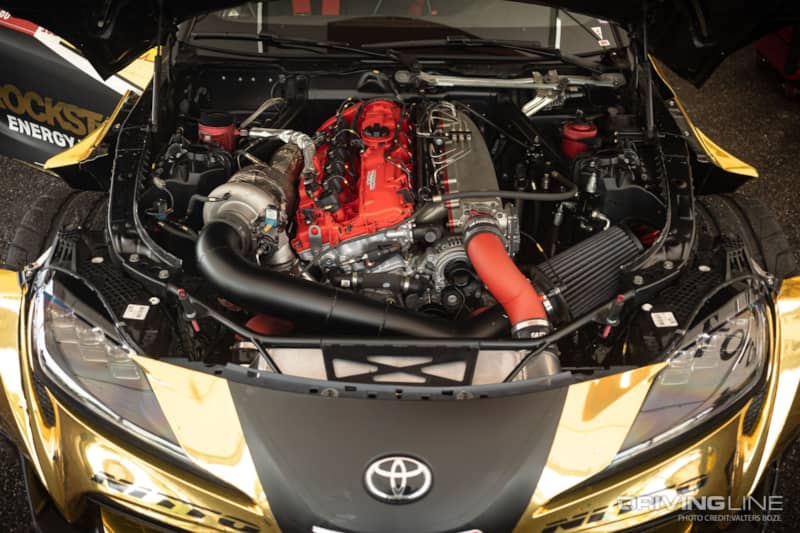
Just 10 short years ago, having over 1,000 horsepower in a drift car was relatively unheard of, but now, the 1,000 horsepower mark is practically a benchmark to be competitive.
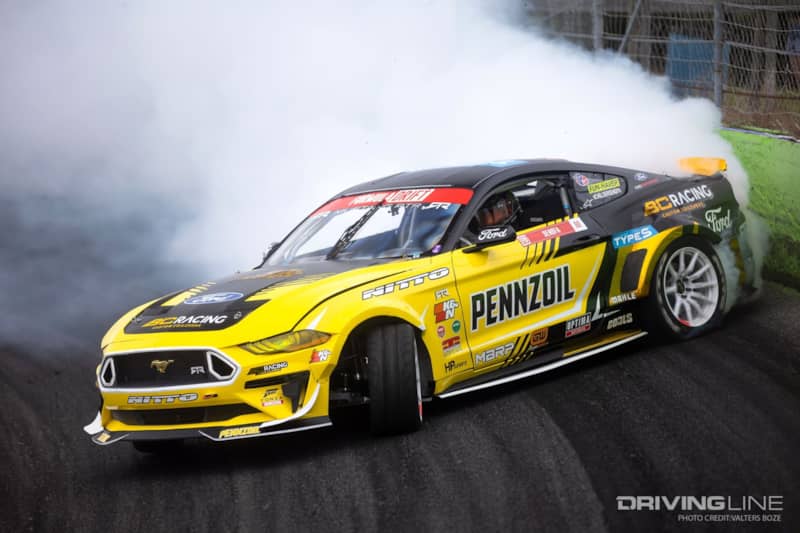
In 2022, the Formula Drift grid features 37 drivers, the majority of which are making over 1,000 horsepower. The grid features engines ranging from 4-cylinder to 12-cylinder, with displacements ranging from just 2.7L up to over 8L of displacement. The Nitto Tire drift team is one of the most diverse, featuring the 4-cylinder 2.7L turbocharged engine in Ryan Tuerck’s Corolla, the 3.2L turbocharged straight-6 engine in Fredric Aasbo’s Toyota Supra GR, and the nitrous-fed Ford-based RY45 engine in both Chelsea Denofa and Adam LZ’s Ford Mustang RTR drift vehicles.
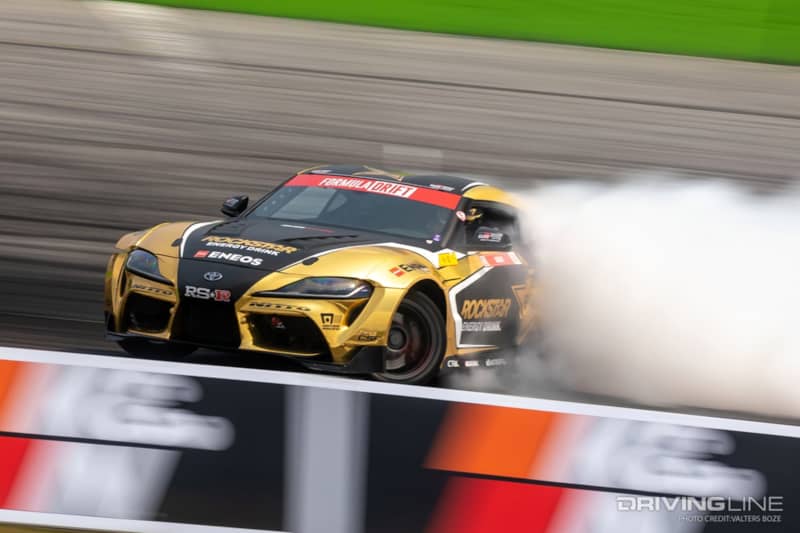
All 3 engine packages push over 1,000 horsepower to the rear Nitto NT555 G2 tires that propel each vehicle, so we decided to take a closer look at what makes up each of these powerhouses.
Ryan Tuerck’s 2.7L Toyota 2AR-FE 4-cylinder Engine
Ryan Tuerck’s 2022 Toyota GR Corolla is one of the only 4-cylinder powered drift cars in competitive drifting that can keep up with the larger displacement engines that are prominent on the grid thanks to the development from famed import drag racer Stephan Papadakis, who owns and operates the team featuring both Tuerck and Aasbo. The original 2AR-FE engine program debuted during the 2011 season when the team introduced the Scion tC2 drift car that Aasbo drove for several seasons before moving into the Corolla that Tuerck now drives, and eventually migrating over to the Supra. In the original form, the engine pushed around 450hp to the rear wheels with a redline around 7,200 RPM. In current form, the engine made 1,007 horsepower on a hub dyno through a Borg Warner EFR9174 turbo, with an additional 150hp dry shot of nitrous to help spool the turbo.
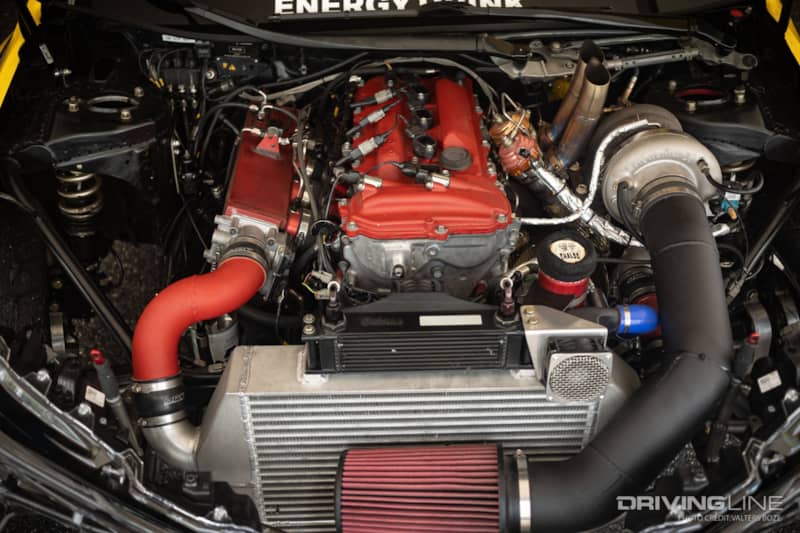
The growth of the horsepower that has taken place over the past 10 seasons came through several progressive steps including bumping up from a 2.5L displacement to a 2.7L displacement, upgrading various valvetrain components to motorsports-grade materials, and several progressive increases in turbo sizing, nitrous jetting, and redline increases as reliability allowed. The current engine features an 8,800 RPM redline, solid lifters, roller rockers, and valve springs, a custom ground cam, a billet crankshaft, and ½” head studs to help prevent some of the gasket sealing issues that arose once the engine package was pushing more than 200hp per cylinder.
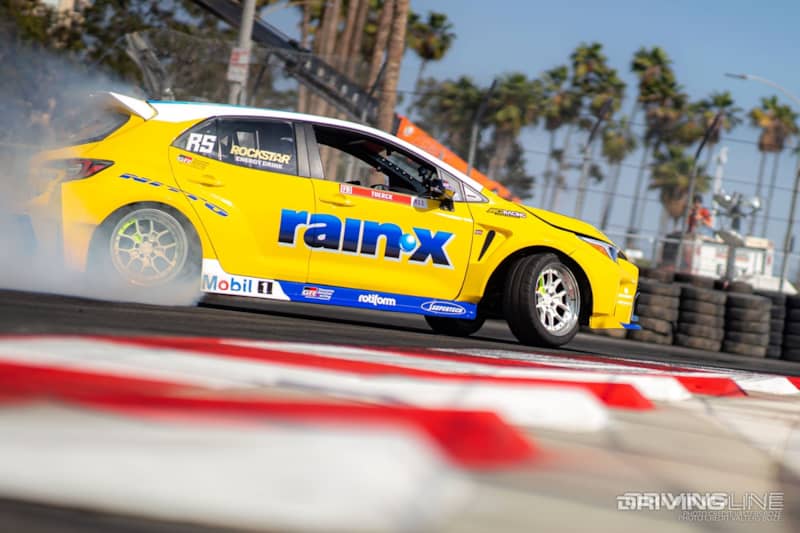
Tuerck piloted the Toyota GR Corolla to a win to start of the 2022 season in Long Beach, and is well positioned at the halfway point of the 2022 Formula Drift season to make another push towards what would be his first overall Championship. To date, Tuerck has scored 2 wins and 8 total podiums while driving the Corolla in just the past two and a half seasons, showing how well developed and reliable the vehicle is when paired with Tuerck’s driving skills. Tuerck competed in his own 2JZ-powered Toyota GT86 prior to joining the Papadakis Racing team in 2020, but also had some seat time behind the ‘demo’ version of the Corolla during the 2019 season at informal events like Gridlife. It’s safe to say that Tuerck feels at home in the Corolla since the switch, and is always a threat to compete for the event win.
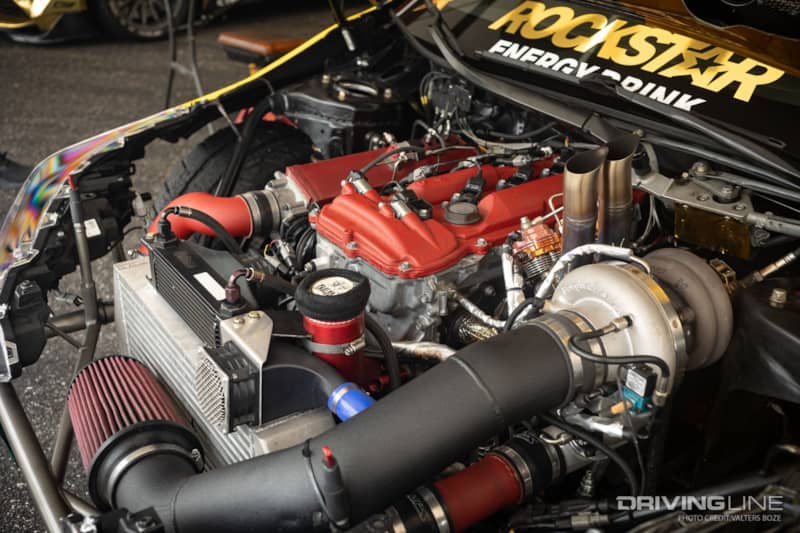
Ryan Tuerck’s I4 2.7L 2AR-FE Engine: Fast Facts
| Engine: | Turbocharged Toyota 2.7L 2AR-FE engine 8,800 RPM redline / 1,007hp / 850 lb-ft torque |
| Drivetrain: | 10.5:1 compression pistons, Supertech Performance valvetrain, Bryant Racing Billet Crankshaft w/ 106mm stroke. |
| Turbocharger & Wastegate: | Borg Warner EFR9174 turbocharger featuring low inertia Gamma-TI Turbine Wheel, dual Tial 38mm MV-S wastegates |
| Fueling & Lubrication: | Dual AEM 380LPH pumps, AEM Fuel Pressure Regulator, 4x Injector Dynamics 2,600cc injectors, dry sump oiling system, Mobil 1 0w50 Racing Oil |
| Nitrous: | 150hp dry shot direct port w/ fueling matched through the ECU |
Fredric Aasbo’s 3.2L B58 6-cylinder Engine
Fredric Aasbo graduated from the Toyota Corolla chassis that Tuerck now drives into the Toyota Supra at the start of the 2020 season, and since then, the Papadakis Racing team has been able to develop the Toyota B58 engine into the 1,000 hp+ powerhouse that sits on the grid today. The original buildup of the engine was documented by Papadakis on a Youtube channel that has seen well over 15M views to date on B58 engine content alone. In its’ current form, the engine has been stroked out to 3.2L in displacement, with some of the biggest improvements in horsepower coming from an OEM upgrade in 2021 to the head. While the team was able to squeeze 1,000 hp out of the original 3.0L engine with a highly restricted head, the 2021 head upgrade and increased stroke which was introduced at the Irwindale final at the end of the 2021 season have allowed the engine to push 1,095 hp at a much lower duty cycle, which has greatly improved reliability.
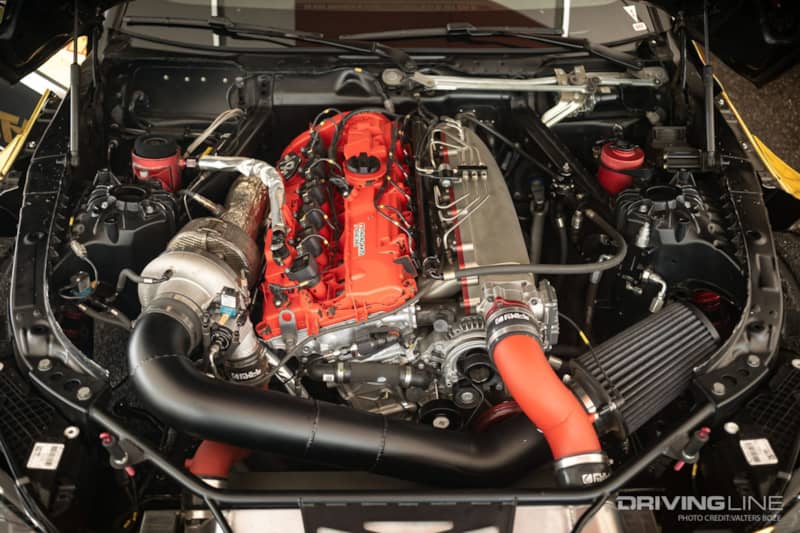
The original 2020 B58 cylinder head only had two exhaust ports in total for the 6-cylinder engine due to how the exhaust manifold was integrated into the head from the factory, which is highly unusual and quite restrictive for high horsepower applications like drifting. Despite that restriction, Papadakis was able to work with Port Flow Design to optimize the configuration to push over 1,000 hp on the dyno, although the team admittedly ran the engine at a much lower boost setting during the inaugural season. The 2021 Toyota Supra came with a more traditional single exhaust port per cylinder design which bumped the stock horsepower up from 335hp to 385hp, and allowed the Papadakis Racing team to improve the overall efficiency of the engine build to handle 1,000 hp at a boost setting that was reliable enough to run at each event. The 2022 configuration now features a Borg Warner EFR9280 turbocharger pushing around 30 pounds of boost, and uses a 150 shot of nitrous to help with spool up. The current configuration ticket off 1,095 horsepower on a chassis dyno in race trim, although the actual amount of boost that is dialed into the setup varies based on the track needs and overall setup.
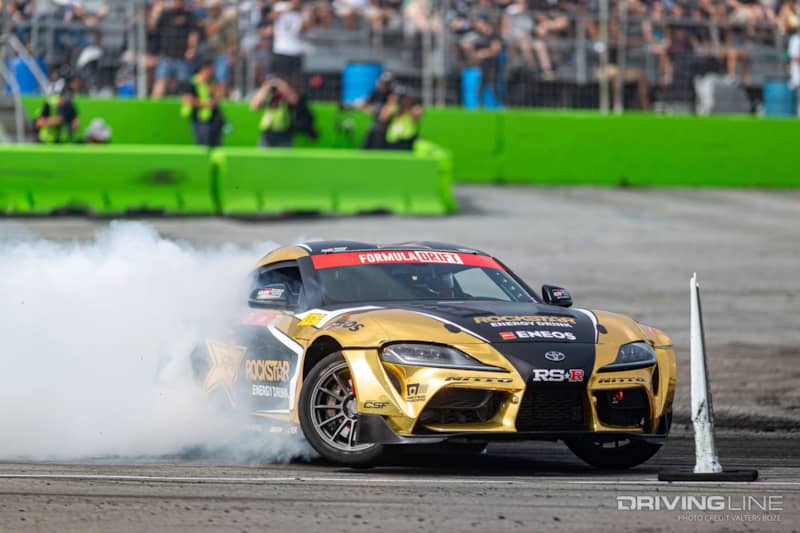
Aasbo was able to slide right into the driver seat of the Toyota Supra and see success quickly, earning a pair of wins in the inaugural 2020 season of the chassis including a win at the inaugural event in Long Beach. Since moving to the Supra, Aasbo has found 4 wins and 12 total podium finishes in just 20 events, including winning the 2021 season championship. It’s clear that Aasbo and the Papadakis Racing team are quite comfortable with the current configuration, although it’s likely that some additional horsepower will find its’ way under the hood as Papadakis isn’t one to stop seeking out improvements!
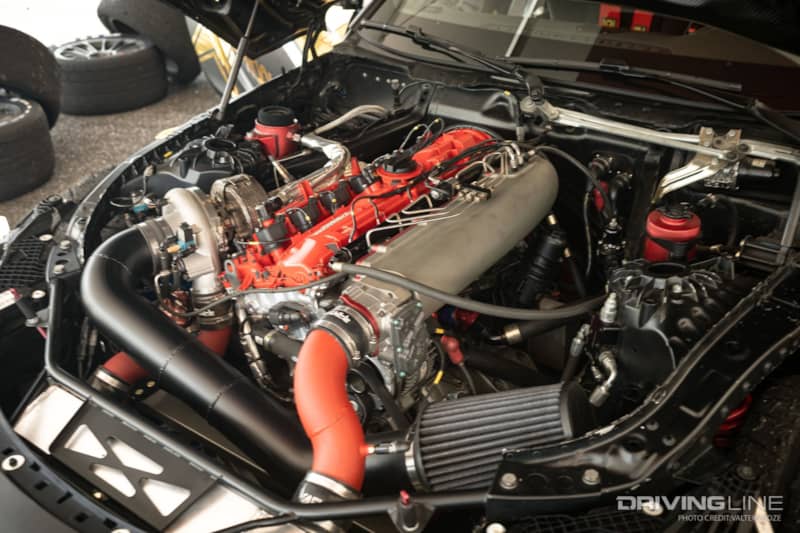
Fredric Aasbo’s 3.2L B58 Engine: Fast Facts
| Engine: | Turbocharged Toyota 3.2L B58 engine 8,700 RPM redline / 1,095hp / 950 lb-ft torque |
| Drivetrain: | 10.5:1 compression pistons, Portflow Design head work, Supertech Performance valvetrain, Kelford billet crankshaft and cams |
| Turbocharger & Wastegate: | Borg Warner EFR9280 turbocharger featuring low inertia Gamma-TI Turbine Wheel, dual Tial 44mm MV-S wastegates |
| Fueling & Lubrication: | Dual AEM 380LPH pumps, AEM Fuel Pressure Regulator, 6x Injector Dynamics 2,600cc injectors, wet sump oiling system, ENEOS 0w50 Oil |
| Nitrous: | 150hp dry shot direct port w/ fueling matched through the ECU |
Chelsea DeNofa and Adam LZ’s Ford Mustang RTR / Roush Yates RY45 V8 Engine
The Ford Mustang RTR drift team features two Mustangs, one driven by Chelsea Denofa and Adam LZ. Under the hood of each Mustang is a small block based racing engine which is a derivative of the Ford NASCAR engine program, originally developed by famed engine builder Roush Yates. Overall, Roush Yates develops engines with a level of consistency and reliability to withstand motorsports such as NASCAR and endurance racing, while drifting has a much shorter period of maximum engine output but a much higher horsepower requirement. While the team saw a lot of success in the early years of the Mustang RTR drift program, they brought in engine specialist Ray Shake to help take the engine package to the next level in 2015. Shake previously was the crew chief for Chris Forsberg Racing for several years, and specifically helped develop the VK56 V8 engine package to be the highest horsepower naturally aspirated Nissan V8 in the world at the time.
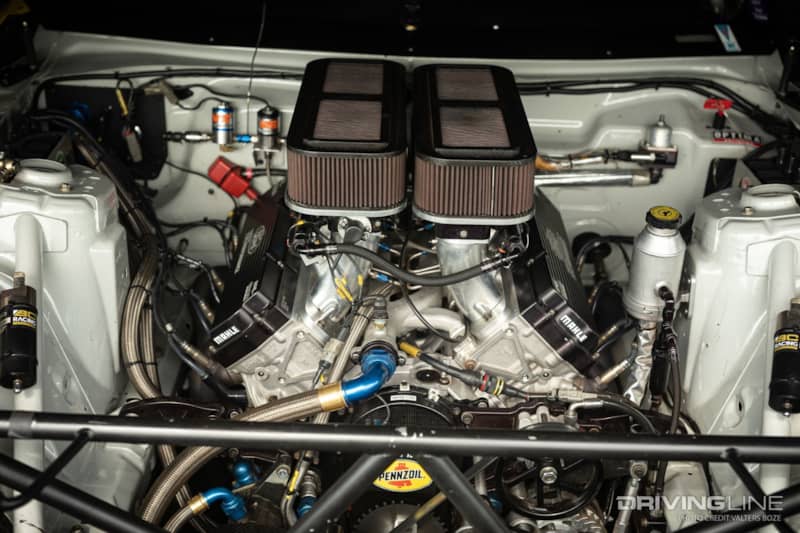
When Shake joined the team, the first change he wanted to make was adding nitrous to the package to help push the engine package over 1,000 hp. During an off-season test, several opportunities were identified to help improve not just the power delivery but reliability as well. Shake worked closely with engine partner Mahle Motorsports and Sandy Wilkens from Roush Yates to design some custom piston designs specifically optimized for nitrous, which eventually lead to a larger conversation with Roush Yates around piston design, ring selection, and other engine details to optimize the nitrous package. Roush Yates is notoriously protective around allowing teams to modify their engine packages, but given the unique demands that are placed on the engine from drifting, Shake was able to work closely with Roush Yates to gain the trust to push the envelope for the relatively new motorsport application.
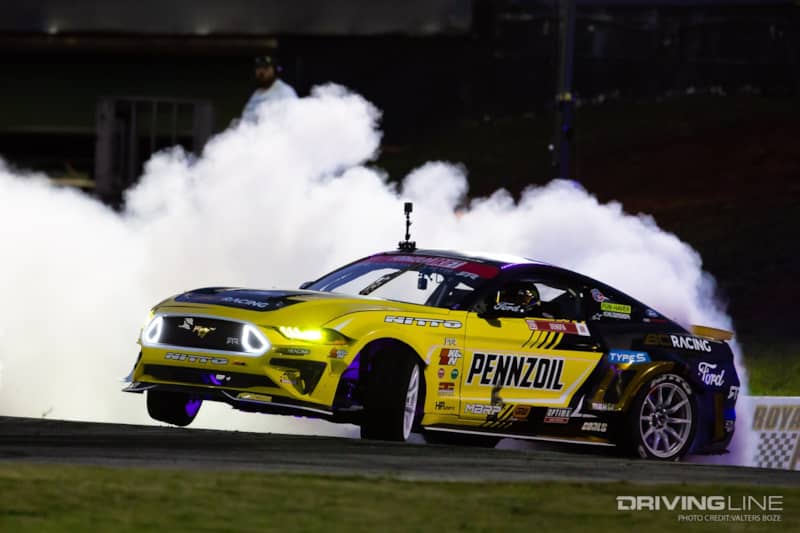
Over several years, the engine package has now evolved to a third generation of piston design, while other improvements to the crank, rods, and other supporting valvetrain components from the early iteration has proved to be sufficient. While Shake was a bit protective on some of the engine component details, he says that the amount of nitrous that is pushed through the engine for each track ranges from around a 50hp setup to a more than 400hp setup. The nitrous is fed through a single Holley NOS nozzle per cylinder, and Shake uses one wideband NTK O2 sensor per cylinder as well as an additional O2 sensor for each bank to monitor and dial in the air/fuel ratios based on the nitrous jet sizes. For any given track, Shake feels comfortable enough tuning for nitrous to swap nitrous jets and adjust the tune without the need to put the engine or the car on a dyno, and often can dial in the optimal engine tune through the NGK spark plugs within a lap or two of his initial tuning configuration.
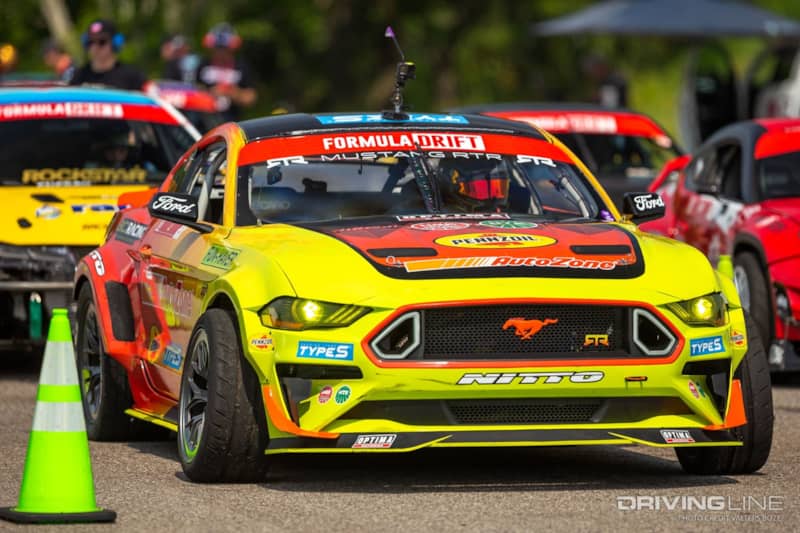
Overall, the Ford Mustang RTR’s have been incredibly reliable since Shake has come onboard, even helping Vaughn Gittin Jr. claim his second Formula Drift season championship in 2020. Denofa has also seen some success in the vehicle, winning in St. Louis in 2020 and claiming second in the championship behind Gittin Jr. overall in 2020. Since then, Gittin Jr. stepped out of the driver seat for the time being, handing the steering wheel over to Adam LZ (who had joined the Nitto Tire team when he stepped into the top “PRO” tier of Formula Drift in 2021). Gittin Jr. still owns and operates the Ford Mustang RTR team behind the scenes, but has been pursuing other business ventures like building a long travel Ford Bronco FunHaver edition, as well as driving off-road at King of the Hammers.
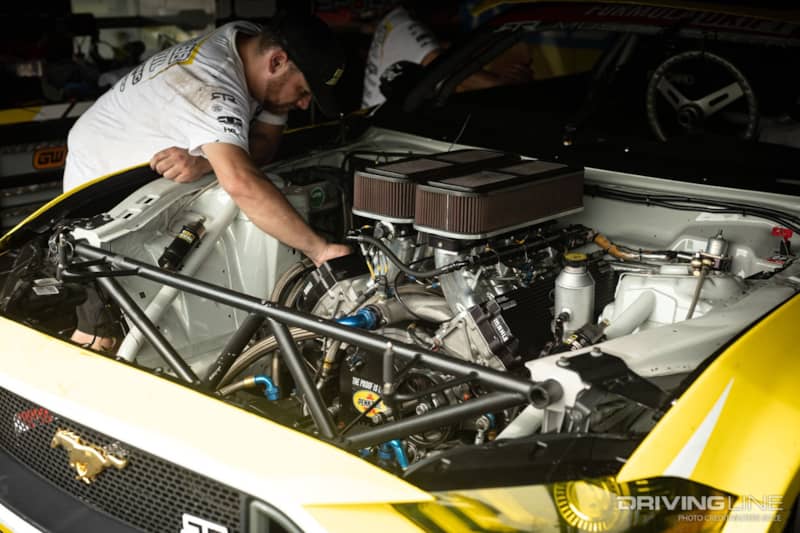
RTR Ford Mustang RY45 engine: Fast Facts
| Engine: | Nitrous-fed Roush Yates RY45 engine (455 cubic inch) 9,200 RPM redline / 900 hp / >1,000 lb-ft torque before nitrous |
| Drivetrain: | RY45 Drivetrain featuring Mahle Motorsports pistons, NGK Spark Plugs, NTK O2 sensors (10x in total) |
| Fueling & Lubrication: | Weldon Fuel Pumps, VP Fuel non-oxygenated C16 fuel, Pennzoil lubricants |
| Nitrous: | Holley NOS 50hp to 400 hp wet shot direct port, controlled via MOTEC ECU |







